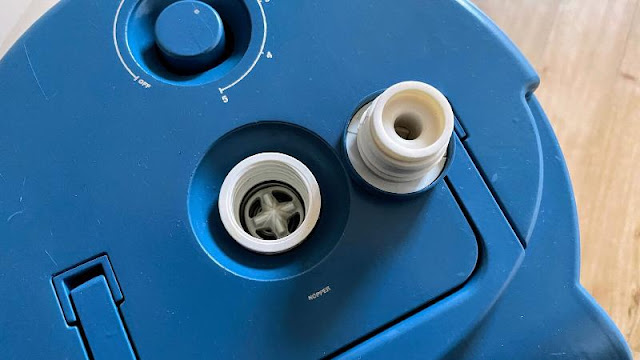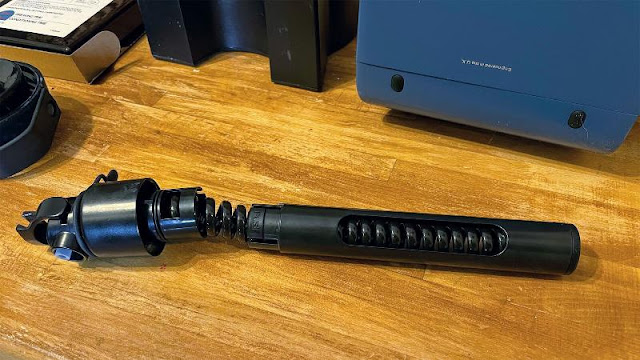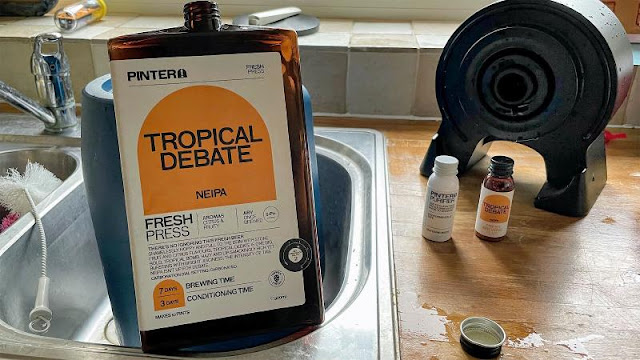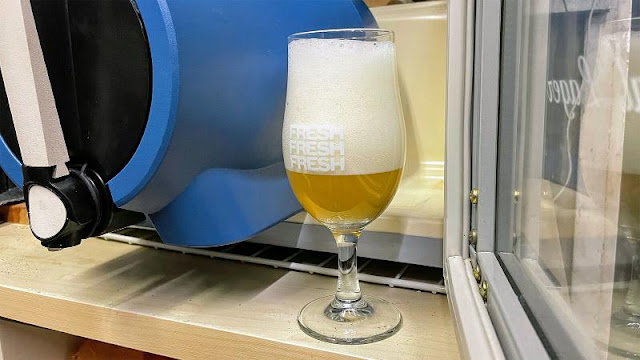With zero knowledge, anyone can brew beer at home with the Pinter 2, and it does it all: fermentation and serving.
Should I Buy The Pinter 2?
Pros
- Virtually foolproof brewing
- Good range of beers
- Hopper does make a noticeable difference
Cons
- Some build quality issues
- Limited selection of Hopper beer
- Takes up a lot of fridge space
Our Verdict
Price When Reviewed
- From £149
The Pinter 2 arrived roughly one year after the original was released. It’s an all-in-one system that includes everything you need to make 10 pints of fresh beer.
That’s because you make the beer in the Pinter and it stays in there once fermentation is finished. You use the handle on the front to pour a pint, and the whole process is so simple that anyone can do it.
In order to make it almost foolproof, there’s a companion app for your phone which includes step-by-step videos that show you exactly what to do, helps you keep track of what stage your beer is at and provides notifications when you need to do something.
It means that if you follow the instructions to the letter, you’ll end up with some tasty beer after a couple of weeks.
Features & Design
- Metal body
- 10-pint capacity
- Hopper allows you to add hop oil during fermentation
The Pinter 2 looks a lot like the first-generation model, but it’s had quite a few improvements. For a start, there’s the ‘Hopper’. It’s a valve on the rear to which you can attach a bottle of hop oil when prompted during the fermentation process, adding aroma to the beer which you otherwise wouldn’t get.
The metal is one of the main reasons for the increased price, but there’s also a completely new tap design. Again, it looks the same, but the mechanism has been redesigned and now comprises a removable section that reaches almost to the back of the Pinter. Inside it is a coiled tube that the beer passes through under pressure (from the natural carbonation) to deliver your pint.
Previously, you’d have to drink the 10 pints within a week or 10 days – a sort of workaround to avoid those problems – but now Pinter says the beer stays fresh for up to 30 days.
Brewing
There’s a decent choice of beer styles, from lagers to ales and fruity IPAs. There’s also cider, if you fancy a change.
It arrives as a ‘fresh press’ along with yeast, a bottle of purifier and – on selected beers – a Hopper bottle. The box is designed to fit through most letterboxes, so you don’t need to be home.
Next, you fill up the Pinter, with cold water and add the fresh press. It’s recommended to use a sanitised jug to fully mix the contents with some water. This avoids a situation where the press ends up in the brewing dock at the bottom and the resulting beer doesn’t taste right.
With some of the thicker presses, such as Space Hopper, you may even need to warm the bottle on a radiator first, and slosh some warm water around the bottle to get the entire contents out.
Then it’s simply a case of pouring in the supplied yeast, attaching the dock and placing the Pinter upright at room temperature for the number of days specified.
Pinter is a bit ambitious with some of the timings, and the higher ABV beers should be left for the longer brewing times – or better still, a full week – to ensure fermentation is complete before conditioning the beer.
If you're brewing a 'Hopper' beer, then just before you remove the dock after fermentation, you unscrew the cap over the valve and screw in the bottle of hop oil. Its foil seal is automatically pierced as you do this. Once the oil is dispensed, the bottle is removed and the cap replaced on the Pinter 2.
What Does The Beer Taste Like?
Brewing beer is a hobby, something people do for fun. And that’s one of main reasons to buy a Pinter 2. Yes, the beer is cheaper than at your local pub, but in my experience at least, it doesn’t always taste better.
Partly that’s because you need to drink those 10 pints while the beer’s still fresh. The company behind the Pinter talks about ‘fresh’ beer a lot, and it’s certainly true that most beer tastes best once it has finished conditioning, and deteriorates over time – especially very hoppy beers.
After that, you’ll notice it doesn’t quite taste as good, and it won’t be as carbonated.
However, when the beer is at its best, which is usually around three weeks after the brew day, it can be very good. Obviously, taste is a subjective thing, but of the beers I’ve brewed, Tropical Debate – the new NEIPA which uses the Hopper – is one of the better ones.
It doesn’t taste obviously like a commercial NEIPA because it lacks bitterness of the usual American hops used, but it does have a nice aroma, a light colour and a lot of fruity notes. Though it has a nominal ABV of 5.6%, my iSpindel – a Wi-Fi hydrometer – reported closer to 6.5%, and it certainly tasted like it.
These gadgets aren’t totally accurate, but if you want to be able to monitor the specific gravity, and temperature of your beer while it ferments, it’s worth the £35 or so investment. (You’ll find pre-built iSpindels for sale on ebay, and they work despite the metal outer shell of the Pinter 2.)
Almost all of the beers have that ‘homebrew’ taste, and it’s something I’ve been unable to avoid, even when using campden tablets to remove the chlorine and chloramine from tap water.
One of tastiest brews was a limited-run red ale made for the 2020 World Cup – hopefully this will become one of the core range, which now includes a sour, a wheat beer, a session IPA and a Vienna lager.
Build Quality
It would be remiss of me to not mention some build quality issues I’ve noticed, as well as those reported by other owners online. My test unit was missing one its rubber feet when it arrived and it was nowhere to be found in the box.
One of the rubber strips on the metal front plate immediately fell off when I first removed it, too. As there are no feet or standoffs on the back, the finish became scratched as soon as I put it in the sink to fill the Pinter 2 for sanitising.
Others have suffered more serious issues, such as where the glue holding the rear metal section (containing the handle) to the main body has failed, causing the beer-filled section to fall off and hit the floor (or smash a hole in their bathtub).
Yet others have had leaks where the fermenting beer has ended up all over the floor: it’s advisable to place the Pinter in a suitable bucket or container to guard against this risk.
To its credit, the Greater Good – the company behind the Pinter 2 – has excellent customer service (there’s live chat in the app) and has sorted out all customers who have experienced these and other problems.
Also, the new metal dock is much easier to attach to the Pinter 2 and, despite being a little more wobbly than the original (which the company says is perfectly normal) has worked fine for the two brews I’ve made so far.
Pricing & Availability
As a startup, Pinter is only available in the UK currently. It costs £149 in any colour, apart from the Pure Finish chrome model which is £209.
You can choose one of two free fresh presses with your Pinter, but this also signs you up to the Fresh Beer Club and you’ll be charged according in subsequent months. Alternatively you can buy them as one-off purchases, with prices ranging from £13 to £20.
That means your pints cost £1.30 to £2 each, not including the cost of the Pinter itself.
You can also buy what’s called a ‘Co-Pinter’ which is a Pinter without the dock. These cost £89, but Fresh Beer Club members get a £20 discount. With a Co-Pinter, you can brew another Fresh Press while your other Pinter is full of a previously made beer.
Verdict
At £149, the Pinter 2 isn’t as giftable as the £85 Pinter 1, but any recipient is sure to be very happy.
The quality of beer can be very good if you go for longer brewing times and don’t expect great results with the short times advertised.
The Fresh Presses are a little too expensive considering they only make 10 pints: similar homebrew kits (such as Woodefordes and Muntons) make 40 pints for considerably less per pint.
However, as mentioned already, the Pinter is more about the hobby than the cost. You’re spoiled for choice if you walk into just about any UK supermarket these days and look in the craft beer section of the beer aisle.
Where the Pinter excels is the system as a whole: it’s easier and more convenient than traditional homebrew kits – mainly because they force you to package your beer after fermentation is complete, but the Pinter 2 doesn’t.











0 comments:
Post a Comment